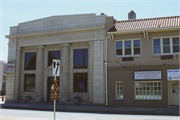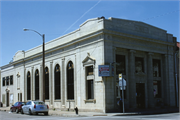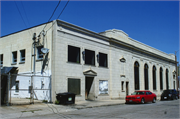Property Record
2803 N TEUTONIA AVE
Architecture and History Inventory
| Historic Name: | Teutonia Avenue State Bank |
|---|---|
| Other Name: | Inner City Development Project Office |
| Contributing: | |
| Reference Number: | 116030 |
| Location (Address): | 2803 N TEUTONIA AVE |
|---|---|
| County: | Milwaukee |
| City: | Milwaukee |
| Township/Village: | |
| Unincorporated Community: | |
| Town: | |
| Range: | |
| Direction: | |
| Section: | |
| Quarter Section: | |
| Quarter/Quarter Section: |
| Year Built: | 1926 |
|---|---|
| Additions: | 1952 1967 |
| Survey Date: | 19792015 |
| Historic Use: | bank/financial institution |
| Architectural Style: | Neoclassical/Beaux Arts |
| Structural System: | |
| Wall Material: | Terra Cotta |
| Architect: | Dick & Bauer |
| Other Buildings On Site: | |
| Demolished?: | No |
| Demolished Date: |
| National/State Register Listing Name: | Not listed |
|---|---|
| National Register Listing Date: | |
| State Register Listing Date: |
| Additional Information: | A 'site file' exists for this property. It contains additional information such as correspondence, newspaper clippings, or historical information. It is a public record and may be viewed in person at the Wisconsin Historical Society, Division of Historic Preservation-Public History. 1979 information: Excellent small Neo-Classical bank of the late 1920s. Construction date, 1926. (Cornerstone) Additional Photos, MI 1-9-34c and 36c. EIS 0338-79/435-80. 1979: Known as Inner City Development Project-North 2016 report: This two-story, Neo-Classical Revival-style bank building is faced with terra cotta along both its street-facing elevations, while the rear elevation consists of brick. The building is comprised of the original 1926 block and a 1952 addition to the rear. The entrance (east) elevation is dominated by two monumental and fluted columns and two partial pilasters of the same design. Plate-glass windows flank the central doorway, while a series of three windows line the second level. The side (south) elevation can be divided into seven bays, each being separated by the other with a fluted pilaster. Five round-arched window openings with replacement fenestration occupy the central five bays. The easternmost bay features a two-window opening that is topped by a full pediment and surround, while the rearmost bay of the original block includes an entrance, a window, as well as a blind window on the second level. The rear 1952 addition is also finished with terra cotta and done in the same style as the main block, however, it lacks the parapet of the 1926 block. Classical detailing, executed in architectural terra cotta, includes dentil molding, as well as the Greek key and floriated motifs. The interior has largely been stripped of its original banking details, as the facility functioned as general offices from 1958 through 1992 and, most recently, as a café and restaurant. Designed by the Milwaukee firm of Dick & Bauer, this facility was constructed in 1926 as the Teutonia Avenue State Bank at an estimated cost of $60,000. The financial institution was incorporated in 1914 and was originally located one block to the south and on the east side of N. Teutonia Avenue (no longer extant). Following its move to the northwest corner of W. Hadley Street and N. Teutonia Avenue, the 1926 building required an addition to the rear in 1952. Still in need of expansion, the bank ultimately moved in 1958 to a new location at N. 60th Street & Capitol Drive and changed its name to Milwaukee Western Bank. The subject building was then owned and occupied by the Association Life Company from 1959 to 1966. The following year, the structure became the third office of the Inner City Development Project (ICDP), a federally supported anti-poverty program that was created by Milwaukee’s Social Development Commission. As of 1970, a temporary American Civil Liberties Union office was established in the building. The building underwent a fire in 1971 and an interior remodel in 1979. The structure continued as the ICDP through at least 1992. Since 2006, the first floor of the structure has served as a café and restaurant, Coffee Makes you Black. 2016 UPDATE: The building continues to house the office of the ICDP to date. 2016 DOE- "The former Teutonia Avenue State Bank/Inner City Development Project Office Building is located at the northwest corner of N. Teutonia Avenue and W. Hadley Street in the City of Milwaukee, Milwaukee County. The face of the building immediately abuts the sidewalk and has an approximate setback of less than 8 feet from the back of curb of N. Teutonia Avenue. The structure is located along a former (approximately 3-block) commercial (shopping) district that developed at the turn of the century and into the 1920s; a residential area of the same period is located to the west. Today, however, the commercial buildings have seen significant alterations and many of them have been replaced by modern construction. Indeed, a vacant lot is located across the street to the east and a modern church and apartment complex occupy the areas to the southeast and south, respectively. The bank, which immediately abuts the building to the north, is recommended as potentially eligible for the National Register. Bank Building (Contributing, 1926-27; 1952): This two-story, Neo-Classical Revival-style, former banking facility is constructed of a combination of hollow tile, brick and stone, with regular and ornamental terra cotta facing both the N. Teutonia Avenue and W. Hadley Street elevations. Both the rectangular and round-arched window openings along the two primary elevations of the main block remain original, although the actual windows themselves have been replaced at least twice; the current examples being tinted plate-glass. A rectangular, two-story addition (1952) extends from the rear of the building. The building's primary (east) elevation is divided into three bay divisions that are modestly recessed and demarcated by two monumental, fluted and engaged Corinthian columns, while the outer two examples are squared off, fluted and engaged, partial pilasters, also with partial Corinthian capitals. The central bay carries a modern, double-door entry that is set beneath ornamental terra cotta that depicts two winged cats/panthers separated by an urn and a scrolled and floriated design above. A rectangular, tinted, plate-glass window is located above the doorway. Each of the outer bays carries a single, tinted, plate-glass window along each level; the two-story window arrangement is finished with an ornamental terra cotta surround that features the Greek key motif and which is topped with a denticulated straight lintel. An entablature runs across the top of the three bay divisions above which is inscribed lettering that identifies the building's original occupant, "Teutonia Avenue State Bank." Floriated terra cotta ornaments each end of that level, which is topped with projecting cornice and further surmounted by a parapet. The year "1926," in raised lettering, is located within a recessed, rectangular panel. Turning to the south (and along W. Hadley Street), the original block of this elevation is divided into seven bays, the interior five of which are outlined by six fluted pilasters. As noted previously, the round-arched window openings are infilled with tinted plate glass; while the uppermost arched area is covered over from the interior and includes modern lighting on the outside. The space below the window features a central terra cotta ornament with a floriated design. The easternmost bay of the original block features a two-light window opening that includes a surround and a panel at its midsection that features a floriated pattern. Topping the opening is a fully pedimented hood with scrolled brackets that also includes a floriated pattern within the pediment. The upper window has been covered over from the inside, while the lower example is tinted plate glass. The first level of the westernmost bay of the original block includes a single entrance with modern door, atop which is some ornamental terra cotta and next to which is a rectangular window opening that is covered over from the interior. Along the upper portion of this bay is a blind window detailed with a full pediment of terra cotta. The building is finished along the upper edge in the same fashion as the primary elevation, with a cornice that includes floriated ornament, as well as a parapet. The 1952 addition completes the structure's south elevation and includes a central and recessed entrance that is highlighted by a fully pedimented hood that includes a roundel at the center. A single rectangular (boarded over) opening is located to either side of the entrance, while three identical rectangular openings (with tinted glass) line the second level. Each opening includes a thin sill below it and label mold above. While the cornice detail continues from the original block, albeit in a less ornate manner, the parapet was not extended over this addition. The building's rear (west) elevation is comprised of common brick that has been painted along the lower level. The first floor retains one window opening that has been infilled with glass block, while the four, upper-level windows carry two-light windows that appear to be original. The building's north wall is immediately adjacent to the building to the north, which was constructed the year before the bank building. Aside from the rear 1952 addition, exterior alterations are limited to the replacement of windows and doors. The original entry doors included an ornamental metalwork panel above. The W. Hadley Street windows (which were originally nine-light examples), were replaced with plate glass during the 1952 addition/remodel work. In 1979, those windows were replaced again with tinted plateglass examples (with seven lights), as were the windows along the entrance elevation. The interior retains very little of its original bank detailing. Indeed, the bank was remodeled in 1952 and a fire did damage to the interior in 1971. Furthermore, the building was completely renovated in 1979 while in use as offices and, more recently, the building was remodeled for use as a cafe, which is now a full-fledged restaurant, complete with a commercial kitchen. The vault, which is used for storage, remains at the rear (along the west wall). The mezzanine level above continues to retain a clock at the center. The bronze railing that once led to the upper level does remain at the front of the building, as does a small bit of the original marble wall finish. The ceilings, which originally featured ornate plasterwork, are now covered by a dropped ceiling, which further covers the interior top edge of the windows along the building's south elevation." -"Teutonia Ave State Bank/Inner City Development Project Office Bldg", WisDOT #2080-00-03, Prepared by Heritage Research, Ltd. (Schnell). (2016). |
|---|---|
| Bibliographic References: | 1979 information: 1. Building Permit, 11 March 1926. 2. 1932 City Directory. 2016 report citations: “North Side Bank Opens Wednesday,” The Milwaukee Sentinel, 21 December 1914, 4/5; Permit for 2803 N. Teutonia Avenue, 11 March 1926; “Civic Cash Left With New Bank,” The Milwaukee Journal, 27 February 1927, 8/5; “Building Improved By Teutonia Bank,” The Milwaukee Journal, 27 January 1952, II-13/4; “Bank Plans Name Switch,” The Milwaukee Journal, 28 September 1957, 11/3; “Insurer Rents Vacant Bank,” The Milwaukee Journal, 10 November 1966, II-25/2-3; Mark Edward Braun, Social Change and the Empowerment of the Poor: Poverty Representation in Milwaukee’s Community Action Programs, 1964-1972 (New York: Lexington Books, 2001), 105; “ACLU Opens Office to Study Complaints,” The Milwaukee Journal, 24 February 1970, Accent, 6/3; “Fire Heavily Damages Social Service Center,” The Milwaukee Journal, 27 February 1971, 18/7-8; Mark F. Pfaller, Associates, “Inner City Development Project: Phase 1 and Phase 2,” Alteration Plans, 8 January 1979 and 31 March 1979, respectively, Plans on file at the WAA, MPL; Milwaukee City Directory, 1992; Molly Snyder, “Coffee Makes You Black Slings Coffee, Community,” Available online at http://onmilwaukee.com/dining/articles/blackcoffee.html, Accessed January 2016. |
| Wisconsin Architecture and History Inventory, State Historic Preservation Office, Wisconsin Historical Society, Madison, Wisconsin |





